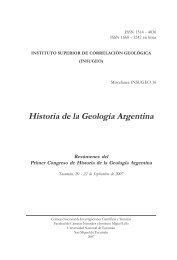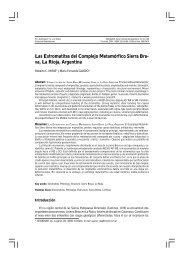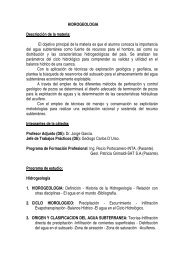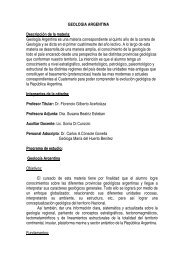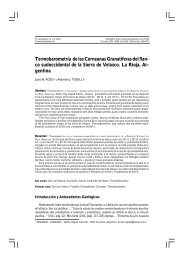Descargue esta publicació en formato pdf haciendo ... - INSUGEO
Descargue esta publicació en formato pdf haciendo ... - INSUGEO
Descargue esta publicació en formato pdf haciendo ... - INSUGEO
You also want an ePaper? Increase the reach of your titles
YUMPU automatically turns print PDFs into web optimized ePapers that Google loves.
Historia de la Geología Arg<strong>en</strong>tina I Serie Correlación Geológica, 24: 179-194<br />
NOTAS F.G. Aceñolaza SOBRE (Coordinador-Editor) LA VIDA Y OBRA DEL DR. EGIDIO FERUGLIO Tucumán, 2008 - ISSN 1514-4186 - ISSN on-line 1666-9479 179<br />
Notas sobre la vida y obra del Dr. Egidio Feruglio<br />
Luis A. SPALLETTI 1<br />
Abstract: NOTES ON THE LIFE AND WORK OF DR. EGIDIO FERUGLIO.- Egidio Feruglio was born on 1 September 1897 at<br />
the family home of Feletto Umberto, Tavagnacco county, Udine, Italy. From his te<strong>en</strong>age years, Egidio Feruglio had held<br />
a ke<strong>en</strong> interest in geology and geomorphology, becoming involved in the Udine´s Speleological Society. After the <strong>en</strong>d of<br />
the World War I, in which he served as an officer of the Italian Army, and at the age of tw<strong>en</strong>ty two years old, he earned<br />
his geologist degree in the University of Flor<strong>en</strong>ce. While at Udine, he worked as a geologist in the Hydrographic and<br />
Agricultural Departm<strong>en</strong>ts. Betwe<strong>en</strong> 1922 and 1925 he served as assistant professor in the University of Cagliari. Egidio<br />
Feruglio was not a politician, but he had strong democratic principles. Wh<strong>en</strong> B<strong>en</strong>ito Mussolini susp<strong>en</strong>ded de political<br />
activities and removed politically suspect employees (including university professors) from their jobs unless they had<br />
demonstrated loyalty to fascism, Feruglio decided to accept a position in the Dirección de Yacimi<strong>en</strong>tos Petrolíferos<br />
Fiscales (the National Oil Copany) of Arg<strong>en</strong>tina. Betwe<strong>en</strong> 1925 and 1928 he worked as a regional geologist in southern<br />
Arg<strong>en</strong>tina (Patagonia). In 1928 he returned to Italy and married Amelia Magrini, with whom he would have two childr<strong>en</strong>,<br />
Ana Eug<strong>en</strong>ia and Arturo. In 1929 he w<strong>en</strong>t back to Arg<strong>en</strong>tina to lead the Geologic Group of the San Jorge Gulf Basin in<br />
Yacimi<strong>en</strong>tos Petrolíferos Fiscales (YPF). In 1932 he relocated again in Italy as a professor in the University of Bologna,<br />
but in 1934 he decided to return to YPF until 1940, wh<strong>en</strong> he accepted a professor position in the University of Cuyo<br />
(M<strong>en</strong>doza), where he organized the Petroleum Institute (1943). After the <strong>en</strong>d of the World War II and the creation of the<br />
Italian Republic the Feruglios decided to move back to Italy. Since 1948 Egidio became professor of Geology of the<br />
University of Turin, but the death of his young son Arturo profoundly grieved him. He decided th<strong>en</strong> to move to the<br />
University of Rome. However, early in 1954 he settled back in his natal place where he died on 14 July at the age of fifty<br />
six years old.<br />
From 1926 to 1957 (three years after his death) Feruglio published a large number of contributions on regional<br />
geology, stratigraphy, paleontology, geomorphology and Quaternary geology of Arg<strong>en</strong>tina, as well as several papers on its<br />
orography and glaciology. The main focus of his regional research was the south of Arg<strong>en</strong>tina and his monum<strong>en</strong>tal work<br />
<strong>en</strong>titled Descripción Geológica de la Patagonia resumes years of field work and data collection. This book was published<br />
by YPF in three volumes, betwe<strong>en</strong> 1949 and 1950. It constitutes a detailed synthesis of the geology, paleontology,<br />
geomorphology and geography of the southern territories of Arg<strong>en</strong>tina. Far from a merely description, Ferugio realized<br />
valuable and well supported interpretations that demonstrated that he had a clear view of the problems of geology and<br />
the determination to solve them.<br />
Egidio Feruglio was one of the most promin<strong>en</strong>t geologists of Arg<strong>en</strong>tina. For early on he discovered his love for<br />
Earth Sci<strong>en</strong>ces. He <strong>en</strong>joyed geology as a whole, since he was able to combine basic research with valuable works on<br />
hydrocarbon exploration and exploitation.<br />
Resum<strong>en</strong>: NOTAS SOBRE LA VIDA Y OBRA DEL DR. EGIDIO FERUGLIO.- Egidio Feruglio nació el 1 de septiembre de 1897,<br />
<strong>en</strong> Feletto Umberto, comuna de Tavagnacco, provincia de Udine, Italia. Después de la finalización de la Primera Guerra<br />
Mundial de la que participó como oficial, y a la edad de 22 años, completó sus estudios universitarios <strong>en</strong> la Universidad de<br />
Flor<strong>en</strong>cia. En sus primeros tiempos como profesional se desempeñó como geólogo <strong>en</strong> la Oficina Hidrográfica y <strong>en</strong> el<br />
Departam<strong>en</strong>to Agrario de Udine, y <strong>en</strong>tre 1922 y 1925 ocupó el cargo de auxiliar doc<strong>en</strong>te de la Cátedra de Geología de la<br />
Universidad de Cagliari. Egidio Feruglio no era un político, pero t<strong>en</strong>ía fuertes convicciones antifascistas. Como consecu<strong>en</strong>cia<br />
de la susp<strong>en</strong>sión de las actividades de los partidos políticos y el aniquilami<strong>en</strong>to de la oposición democrática por<br />
parte de B<strong>en</strong>ito Mussolini, decidió emigrar a la República Arg<strong>en</strong>tina <strong>en</strong> 1925, incorporándose como geólogo de la <strong>en</strong>tonces<br />
Dirección de Yacimi<strong>en</strong>tos Petrolíferos Fiscales donde inicia sus trabajos profesionales y de investigación <strong>en</strong> la región<br />
patagónica.<br />
En 1928 regresa a Italia y contrae matrimonio con la señorita Amelia Magrini. De <strong>esta</strong> unión nacerán dos hijos Anna<br />
Eug<strong>en</strong>ia y Arturo. En 1929 se instala nuevam<strong>en</strong>te <strong>en</strong> YPF donde ocupa las funciones de Jefe de Comisión y luego Jefe del<br />
Grupo Geológico del Golfo San Jorge hasta el 1932, año <strong>en</strong> que acepta el cargo de profesor <strong>en</strong> la Universidad de Bologna.<br />
No obstante, <strong>en</strong> 1934, retorna a nuestro país para retomar su actividad profesional <strong>en</strong> la empresa petrolera <strong>esta</strong>tal. En<br />
1940 acepta la designación de profesor <strong>en</strong> la Escuela de Agronomía de la Universidad de Cuyo, y <strong>en</strong> 1943 organiza y dirige<br />
el Instituto del Petróleo. Permanece <strong>en</strong> M<strong>en</strong>doza hasta 1948. Terminada la Segunda Guerra Mundial e instaurada la<br />
república italiana, regresa definitivam<strong>en</strong>te a su país donde ejerce las funciones de profesor <strong>en</strong> las universidades de Turín y<br />
de Roma. A principios de 1954 vuelve a Udine donde fallece el 14 de julio, a la edad de 56 años.<br />
1<br />
C<strong>en</strong>tro de Investigaciones Geológicas (UNLP-CONICET), calle 1 nº 644, B1900TAC La Plata.<br />
spalle@cig.museo.unlp.edu.ar


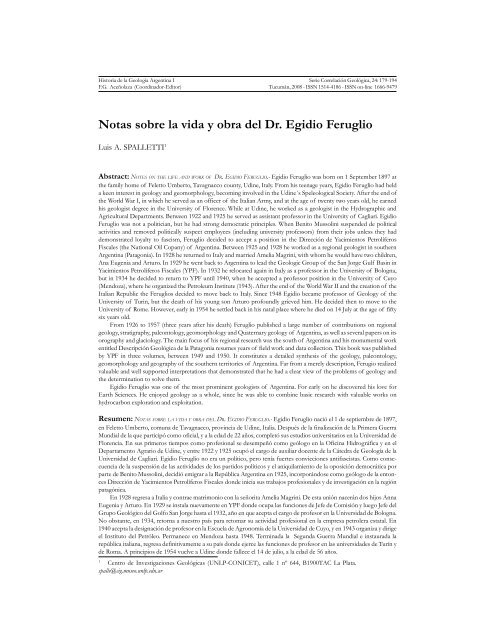
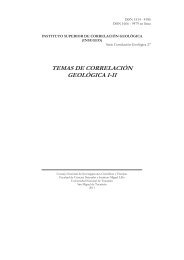
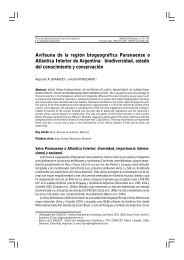

![Descargar El Libro Completo [5.631 Kb] - INSUGEO](https://img.yumpu.com/40710231/1/177x260/descargar-el-libro-completo-5631-kb-insugeo.jpg?quality=85)



